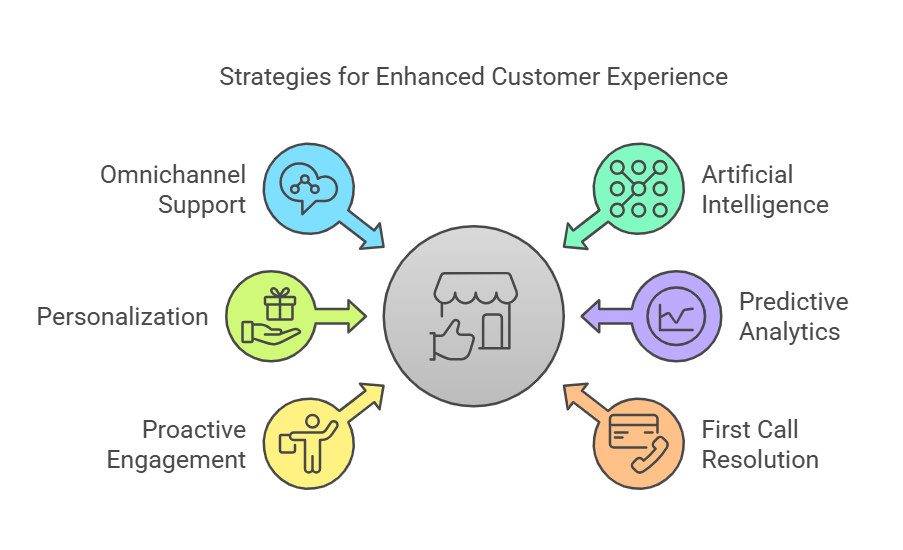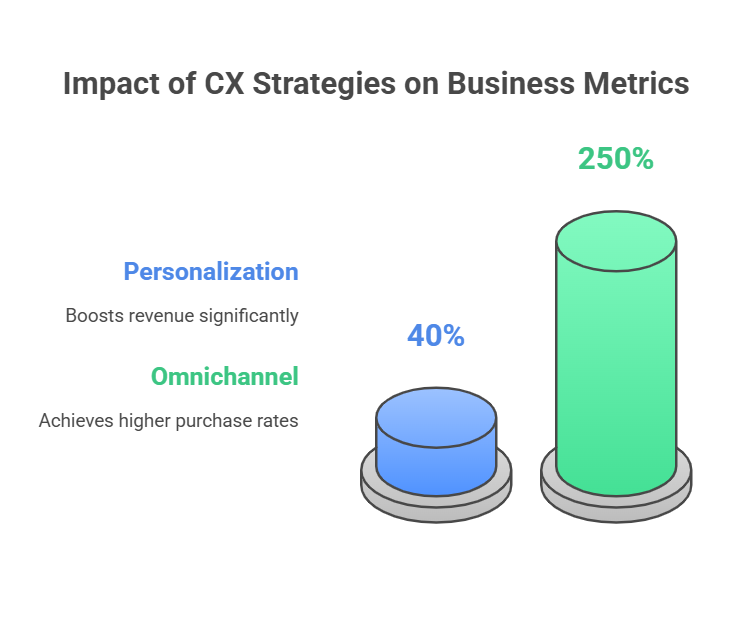Contact Center Innovation: 15 Customer Experience Strategies That Drive Results
21 Jan 2025 By: Mary Dellosa
Updated

In today’s competitive market, delivering great customer experiences sets businesses apart. Contact centers, as the frontline, shape customer perceptions of a brand. Yet, changing expectations and new technologies make outdated methods ineffective.
To stay efficient and customer-focused, contact centers must innovate. Here are 15 proven customer experience strategies to enhance customer experience and keep your contact center ahead.

1. Implement Omnichannel Support
Customers want to connect with your business in ways that work best for them—like phone, email, chat, social media, or text. An omnichannel system ties these together, so every interaction feels smooth. If someone starts chatting online and calls later, agents can see the full history. This avoids the frustration of repeating details.
Businesses with strong omnichannel systems keep 89% of customers, compared to just 33% for those without. Connecting your channels makes things easier, builds trust, and keeps customers loyal.
2. Leverage Artificial Intelligence (AI)
Artificial intelligence is transforming contact centers. AI chatbots handle simple tasks like order updates or troubleshooting, freeing agents to solve complex problems. AI tools also help agents during calls by suggesting responses or solutions based on the conversation.
AI goes further by spotting trends in customer behavior to help managers make smarter decisions. Predictive analytics can anticipate customer needs and drive proactive engagement. For example, if AI notices a customer viewing cancellation policies, an agent can step in with options to keep them. This creates a more personalized, standout experience.
3. Personalize Every Interaction
Personalization isn’t a luxury anymore, it’s what customers look for. They love it when businesses truly understand them and make them feel special. By using details like past purchases or previous conversations, you can create a more personal and meaningful experience.
Think about a travel agency suggesting a trip based on a customer’s favorite vacations. It’s thoughtful and shows you care. This kind of connection builds trust and loyalty. In fact, 80% of people say they’re more likely to buy from brands that make their experiences personal.
4. Use Predictive Analytics
Predictive analytics makes personalization even smarter by anticipating what customers need before they ask. It uses past data to spot trends and predict future actions. For example, a software company could predict if a customer might renew or cancel their subscription based on how often they use the product.
This insight helps contact centers act before problems arise. Imagine reaching out to offer a solution before a customer even notices an issue. It’s proactive, solves problems quickly, and shows customers you truly care about their experience.
5. Prioritize Proactive Engagement
Proactive engagement means reaching out to customers first instead of waiting for them to contact you. This can include reminders, updates, or solving issues before they arise. For example, a utility company might notify customers about a scheduled outage and share tips to reduce inconvenience.
Taking the initiative builds trust and prevents complaints. It shows customers you value their time and experience. Proactive engagement strengthens loyalty and helps create lasting relationships.
6. Focus on First Call Resolution (FCR)
First Call Resolution (FCR) is vital for contact centers. Solving issues in the first interaction reduces frustration and improves customer satisfaction. To achieve this, agents need proper training, access to the right tools, and decision-making authority.
For instance, using an integrated CRM lets agents quickly view customer details for faster solutions. Empowering agents to resolve issues without constant escalations ensures quicker results and leaves customers feeling valued and happy.
7. Invest in Employee Training and Development
Your agents are the heart of your contact center. When they feel supported, they give their best to your customers. Training isn’t just about systems—it’s about building skills like empathy, listening, and solving problems.
When you show agents they can grow with your company, it boosts their confidence and keeps them around. Happy agents create great experiences that keep customers coming back.
8. Optimize Self-Service Options
Today’s customers like solving problems on their own. A good self-service portal with FAQs, guides, videos, and troubleshooting tools helps them find answers fast. In addition to portals, displaying important updates or quick help options in waiting areas using a digital signage solution can further streamline the customer experience and reduce call volume.
Gartner reports that 70% of customers prefer using a website over contacting support. Offering simple, effective self-service options reduces calls and boosts satisfaction.
9. Monitor and Analyze Customer Feedback
Customer feedback is a treasure trove for growth. Surveys, reviews, and chats help you see what’s working and what needs fixing. Tools like NPS and CSAT offer clear insights.
But feedback alone isn’t enough. Acting on it shows customers you care. If they often mention long wait times, solutions like better call routing or more staff during busy hours can make a real difference.
10. Incorporate Speech and Sentiment Analysis
Advanced tools can analyze customer conversations in real time to understand emotions. Speech and sentiment analysis picks up on frustration, satisfaction, or confusion through tone, words, and speech pace.
For example, if a tool detects rising frustration, it can alert a supervisor or suggest an empathetic response to the agent. This helps resolve issues quickly and prevents negative experiences.
11. Maintain a Secure and Reliable Infrastructure
Customers want to feel safe when sharing their personal information. Following laws like GDPR or CCPA isn’t just a rule—it shows you care about protecting their data. Adding tools like encryption and two-factor authentication helps build trust and gives customers peace of mind.
Reliable systems matter too. No one likes dealing with crashes or delays. Regular updates, backups, and maintenance keep things running smoothly, so customers feel supported every time they reach out.
12. Reduce Wait Times with Intelligent Call Routing
Long wait times frustrate customers more than almost anything. AI-powered call routing helps by connecting callers to the right agent based on their needs, language, or past interactions. This speeds things up and ensures customers get the right help quickly.
Offering callback options during busy times is another great way to reduce stress. It lets customers get the help they need without waiting on hold, giving them more control and a better experience.
13. Empower Agents with Real-Time Insights
Giving agents real-time access to customer information is key to great service. A centralized CRM shows customer history, preferences, and past interactions all in one place.
For example, if a customer calls about a delayed order, the agent can instantly check tracking info and offer a solution—no hold time needed. When agents have the tools they need, they resolve issues faster, making customers happy.
14. Gamify the Workplace
Gamification makes work more fun and engaging for agents. Using leaderboards, rewards, and recognition for hitting goals inspires healthy competition and boosts performance.
For example, rewarding agents for high FCR rates or great customer feedback fosters a culture of excellence. Happy, motivated agents provide better service, improving customer experience and driving business success.
15. Measure Performance with Key Metrics
Tracking key performance indicators (KPIs) is crucial for growth. Metrics like Average Handle Time (AHT), Customer Effort Score (CES), and First Call Resolution (FCR) show how well your team is performing.
Reviewing these regularly helps spot trends and areas to improve. For example, if AHT is too high, it might mean agents need more training or simpler processes. Sharing these insights with your team builds transparency and motivates everyone to improve customer experiences together.
Trending Now
Customer experience (CX) is a critical driver of business success heading into 2025, with 89% of companies expected to compete primarily on CX. Many turn to customer experience outsourcing to enhance their strategies and improve service. Trends like personalization, omnichannel consistency, and proactive engagement dominate modern strategies, delivering higher revenue and retention rates. Personalization alone boosts revenue by 40%, while omnichannel approaches achieve 250% higher purchase rates. AI further transforms CX with automation, predictive analytics, and hyper-personalization, enabling tailored, real-time interactions and significant operational efficiencies.

Challenges remain, including rising customer expectations, data privacy concerns, and balancing automation with human empathy. Addressing these, alongside sustainability as a CX differentiator, positions businesses for competitive advantage. With modest CX investments yielding substantial ROI, organizations prioritizing customer trust, technological innovation, and employee empowerment will achieve long-term growth and differentiation.
Ready to Elevate Your Contact Center?
Innovation in contact centers goes beyond technology—it’s about building real connections with customers. By using these 15 strategies, you can exceed expectations, build loyalty, and drive results.
From using AI and omnichannel support to focusing on proactive engagement and empowering employees, these steps meet both customer and business needs. Success comes from always improving and putting customers first.
At HelpSquad, we specialize in delivering exceptional customer experiences through innovative solutions tailored to your business needs. Let’s work together to create a contact center that not only meets but exceeds expectations. Contact us today to learn more!


